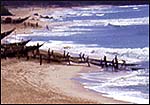


|
|
 |
| HOME | TRAVEL | TRAVELOG | ||

Konkan Country ... the beautiful coast of Maharashtra
Text and photographs: Nilesh Korgaonkar
I headed for Anjanvel and Guhaghar. Enron is setting up its power project north of the coastal town of Guhaghar on the southern banks of the Vashishti, just as the river meets the Arabian Sea. Dabhol, which is now synonymous with the power plant, is actually located on the northern bank of the river. The area was easily accessible by road. We first hit the town of Chiplun on NH 17, the Bombay-Goa national highway and at Chiplun a road forks off for the final 40 km to Guhaghar. My aim was to find a good location to camp for the day and enjoy the solitude of a lonely strip of coast. The map I was carrying indicated a promising stretch just west of the village of Anjanvel. It also indicated a ruined fort right next to the sea by the name of Gopalgarh. Nothing, in my opinion, adds to the serenity of a seascape, more than the stolid presence of a historic monument nearby. A silent monolith shrouded in history, myth and mystery. And the sound of a constant crescendo of waves beating upon its battlements. It makes the imagination run wild.
So instead of taking the road that led to the jetty for the ferry to Dabhol, I took the track that turned left and sloped down steeply to the fishing creek and the village of Anjanvel. When I asked at the small shops about the location of the fort, the local boys indicated a small path disappearing over a hillock into fairly thick woods. Scrambling up I soon emerged from the woods and the steep slope soon yielded to a gentle plateau covered with small fields. The plateau sloped upwards very gently to the west and towards the sea. On reaching the edge of the plateau the view was beyond my wildest expectations. It was like the unfolding of a slow motion sequence of a film, shot from a helicopter skimming just above the ground and approaching the sea. Until I came just ten feet short of the edge, I could not tell what lay ahead. The plateau suddenly dropped down steeply about 500 feet to a rocky shoreline without a beach. And the vast expanse of sea suddenly became visible. To the right, the ramparts of the fort snaked down the slope almost to the water's edge probably to cater to the visitors to the fort who came by sea. Beyond the fort, the Vashishti river opened out to the sea in an estuary. To the left, the plateau took a gentle curve and reached out further into the sea. At its edge nestled a lighthouse with its tiny colony of houses. Near the lighthouse I could also see the spires of two temples. For a long while I simply stood there. Absorbing the serenity. And letting the salty sea breeze blow against my face and the sound of the battling waves down below sing in my ears. And then I sat down on the grassy slope wishing time would simply stop. The gently chugging of a fishing trawler passing below, hugging the shore, probably going home with its catch, only added to the sounds of silence.
With the greatest reluctance I realised that I had to leave. Already the sun was dipping into the ocean. It was beginning to get dark and I didn't have a flashlight to guide me back down. My last thoughts as I clambered down the slope to my car was whether this countryside would remain this way once the power project, just a few miles behind me, went on stream. For once I wished that the adage, 'so near yet so far' would remain true. Media reports had said that the fuel would be natural gas from across the sea. That meant an ugly jetty to receive the fuel for the plant would soon spoil the estuary.
Just a few hundred yards from the Pethes was a reasonably clean khanawal where we had a chance to sample what there is to be sampled in coastal village. Fish curry and rice. Guhaghar beach, located in a gentle curve of the coast, was about a couple of kilometers long. It was clean, empty and the coconut groves provided adequate shade from the sun when it got really hot. There was a path to the beach running right past the Pethe's house. The beach looked great at night. Starlit. And peaceful. The periodic flash of the lighthouse at Anjanvel sweeping the dark skies at intervals added atmosphere. We drove home the next day. Will we ever have a chance to come back... before Enron changes this landscape forever?
|
|
| Fast Facts | |
|
|
|
|
HOME |
NEWS |
BUSINESS |
CRICKET |
MOVIES |
CHAT
INFOTECH | TRAVEL | LIFE/STYLE | FREEDOM | FEEDBACK |
|